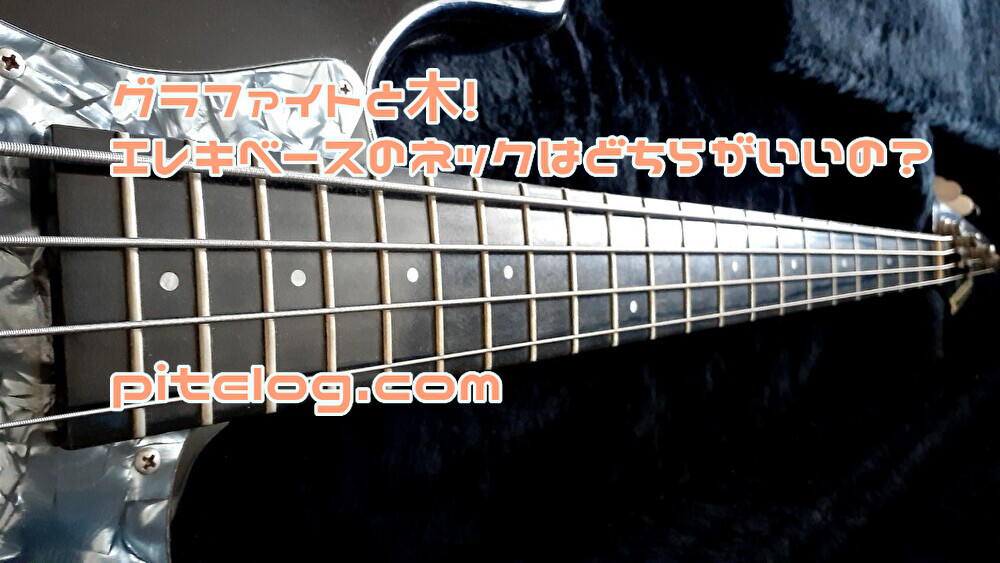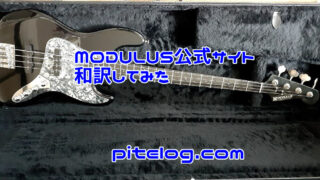くむ(@c_moon_wfh)です。
明日から弾くエレキベースを選ぶにあたって、グラファイトネックと木のネックという選択肢があります!
かたや近未来感あふれる航空宇宙グレードのグラファイト素材、かたや伝統文化と暖かみを感じるウッド素材。
どちらも魅力的な素材なんですが、
あなたはどちらがいいですか?
♱⋰ ⋱✮⋰ ⋱♱⋰ ⋱✮⋰ ⋱♱⋰ ⋱✮⋰ ⋱♱⋰⋱✮⋰⋱
【結論】何を優先するかによる
これからベースを買おうとしているあなたは、たくさんある楽器の中からどのネック材のベースにしようか迷ってしまうかもしれませんね!
結論から言うと、あなたが何を優先するかによります。
ベースのネック素材を選ぶことは求めるサウンドと演奏性の両方に影響するため、かなり重要です。
最も人気のある2つのオプション(選択肢)は、グラファイトとウッド。
どちらも利点はありますが、求めるサウンドやスタイルに合ったものを検討することが大切ですね。
グラファイトは圧倒的な耐久性と安定性があり、かたやウッドは多彩な音色と温かみのある感触が得られます。
つまりグラファイトネックとウッドネックのどちらを選ぶかは、楽器に何を求めるかによって決めると良いですね。
耐久性や安定性、コスパを優先するか?
それとも、暖かみのあるトーンや伝統美を持つウッドネックがいいのか?
このブログでは両ネック素材の利点を深く掘り下げ、どちらがあなたのスタイルに一番なのかを考えてみましょう。
ただし、世界に唯一のひたすら珍しい楽器を探し求める楽器コレクターさんはこの限りではありません。
♱⋰ ⋱✮⋰ ⋱♱⋰ ⋱✮⋰ ⋱♱⋰ ⋱✮⋰ ⋱♱⋰⋱✮⋰⋱
クラゲの楽天ROOMのぞいてみてね~
↑お陰様で完売しました。ありがとうございました。
♱⋰ ⋱✮⋰ ⋱♱⋰ ⋱✮⋰ ⋱♱⋰ ⋱✮⋰ ⋱♱⋰⋱✮⋰⋱
さて、ベースのネックに適した素材を選ぶ際には、失敗を避けるためにいろんな選択肢の利点を比較検討することが大切ですよね。
グラファイトと木材はベースネックに使用される最も一般的な素材の2つで、それぞれに独自の利点があります。
グラファイト・ベースネックのメリット
まずは、ベースネックの素材としてのグラファイトのメリットについて考えてみましょう。
グラファイトネックは滑らかな仕上がりで握り心地も良いので、摩擦や不快感を感じることなくネックのローからハイまでストレスなくポジション移動することができます。
さらに、もっとすごいメリットがあるんです。
先述の通りグラファイトは非常に高い耐久性を持つ素材で強度が驚異的に高く、スラッピングのようなハードな奏法に耐えられるネックを好むミュージシャンにも人気があります。
レッド・ホット・チリ・ペッパーズのフリーもモジュラスグラファイトのシグネチャーベースを愛用していますね。
グラファイトネックは(常識的な範囲での)温度や湿度の変化に一切影響されないので、ネックの反りや歪みを心配する必要はありません。
つまりグラファイトネックは、この先何年も何十年も基本メンテフリーで問題なく使えると言っても過言ではないんです。
ネックの調整にかかるお金がいらないのでコスパ良きですね!※
さらにグラファイトには、ウッドや他の素材では再現できない独特の音色がありますね。
ファンク、ポップス、ロック、フュージョンなど、現代・未来の音楽スタイルに相応しい明るい輪郭のクリアなサウンドを生み出します。
より音の立ち上がりが速くアタック感のあるモダンなハイパーサウンドの楽器をお探しなら、グラファイトはあなたの音楽人生におけるパートナーとして最適な素材と言えるでしょう。
※
ナットやフレットなどの消耗品に関してはメンテが必要です
モジュラス(Modulus Graphite)公式サイトもみてみよう
以前の記事も併せてご参照下さい↓
次のセクションでは、木材があなたの望むサウンドを引き出せるかどうかみていきましょう。
ウッドベースネックのメリット
次に何世紀にもわたって作られてきたウッド・ベースネックの良いところは、いまさら語るまでもないかもしれませんね。
この素材について知るべき重要なことは何でしょうか?
まず最初に、素材としての木材の定義と特性です。
木は有機物であり、小さな繊維が接着されてできている。
そのため強度が高く安定した素材であり、ベースギターのネックを作るのに適しています。
木材の種類によってそれぞれの性質があり、硬いものもあれば、柔らかいものもあります。しかしどの種類の木材にも個性があり、自分に合ったものを見つけることが大切です。
そして、ベースネックにウッドを使用するメリットをみていきましょう。
グラファイトの対抗馬であるウッドは長年多くのベースプレイヤーの間で愛され続けている素材ですが、それには理由があります。
自然で有機的な感触を持ち、人の手に馴染みやすいことです。
この素材は手に優しいので、長時間の演奏にもストレスなく扱えますね。
また木材は優れた絶縁体であり、ベースのサウンドの自然な暖かさを保つのに役立ちます。
さらに視覚的にも魅力的な素材であり、木目がクラシックな美しさを備えているので、レトロな雰囲気を表現したいミュージシャンにもおすすめです。
ベースネックの木の種類
続いて、ベースネックに使われる様々な木材とその特徴について説明しましょう。
ベースに適した木材を選ぶとき、選択肢に事欠くことはないでしょう。
メイプル、マホガニー、ローズウッド、エボニーなどがベースネックに使われる木材の主な品種です。
それぞれの木材には特徴があり、それがベースの音色やフィーリングに大きく影響します。木材の音色反応に関しては、暖かみと深みがポイントです。
木材の自然な音色は豊かで暖かく深みのあるサウンドを生み出しますが、これは一種のナチュラル・リバーブだと考えてください。
この音色は多くのベーシストから好まれるもので、それには十分な理由があります。
音楽のスタイルに合った木材を選ぶことが大切ですね。
木材はベースネックの素材としては信頼できる選択であり、現代のウッドネックは試行錯誤を重ねた結果でもある。
ウッドネックは伝統的で快適な演奏体験を生み出す全ての要素を備え、人口的には再現しにくい自然な暖かみを備えています。
グラファイトと木、それぞれの長所と短所
ベース用ネックにおけるグラファイトとウッドの利点については、いくつかの大切な比較項目があります。
【音色】お好みで
まずサステインとブライトネスについてですが、グラファイトネックはウッドネックに比べサステインが長く、ブライトな音色が特徴です。
これは特定のジャンルの音楽には最適ですが、ウッドネックの持つ暖かく丸みのある音色を好むプレイヤーもいます。
【演奏性】お好みで
弾きやすさについては、どちらの素材にも利点があります。
グラファイトネックはその滑らかな感触と近未来感のある音色がよく評価されますが、ウッドネックはより暖かみのある触覚フィードバックと、より伝統的な演奏体験を得ることができます。
そして重さや快適性については、グラファイトネックはやや軽量なものが多く、長時間演奏しても快適な傾向にあります。
しかし、ソリッドウッドネックの重さや感触を好むプレイヤーもおり、それはベースのトーンキャラクターをより際立たせることにもなります。
【メンテナンス】グラファイトがいい
最後に、メンテナンスと安定性です。
グラファイトネックは一般的に温度や湿度の変化に強く、ウッドネックよりもメンテナンスの手間が省けます。
とはいえウッドネックは調整や修理が比較的容易であるため、プレーヤーによってはより実用的な選択肢となりえます。ただ定期的なメンテにお金はかかりますね。
【全体的には】お好みで
このように、グラファイトネックとウッドネックのどちらにも長所と短所があります。最終的には、個人の好み、演奏スタイル、音楽のジャンルによるでしょう。
ハイテクでモダンなグラファイトを好むミュージシャンもいれば、温かみのあるナチュラルなウッドを好むミュージシャンもいます。
結局のところ正解も不正解もなく、あなたとあなたの音楽にとって何がベストなのかを考慮すると良いでしょう。
なお、SDGs的に地球環境に優しいのはグラファイトネックになりますね。
個人的には、やっぱりグラファイトの楽器が好きです。
まとめ
まとめとして、ベースのネックの素材はグラファイトとウッドのどちらが良いのでしょうか?
まあ、お察しの通り答えは1つに決められません。
どちらの素材にも独自の利点と欠点があります。
最終的には個人の好みと、ベースネックに何を求めているかということになります。
楽器屋さんなどでのセレンディピティ的な出会いも大切にしてください。
とにかく耐久性のある丈夫なネックをお探しで、今後のメンテにかかる費用を抑えたいなら、グラファイトが断然おすすめです。
しかし、より伝統的で温かみのあるナチュラルなサウンドを求めるのであれば、ウッドの方が良いかもしれません。
両者を選ぶ際には、ネックの重量、サスティン、演奏性、メンテナンス性、安定性などの要素を考慮することが重要です。
それぞれの素材には異なる特徴があり、あるプレイヤーにはより効果的で、他のプレイヤーにはそうでもないかもしれません。
結局のところ、グラファイトネックとウッドネックの選択はまさに主観的なものであり、最終的にはあなたにとって最高のフィーリングとサウンドが得られるかどうかということに尽きます。
できれば楽器屋さんで両方の素材を試してみて、どちらが自分に一番響くか確かめてみてください!
♱⋰ ⋱✮⋰ ⋱♱⋰ ⋱✮⋰ ⋱♱⋰ ⋱✮⋰ ⋱♱⋰⋱✮⋰⋱
Graphite vs. Wood: Comparing the Benefits of Bass Neck Materials
Table of contents
• Introduction
• Graphite Bass Neck
• Wood Bass Neck
• Comparing the Benefits
• Conclusion
Introduction
So, you’re about to buy a bass and you’re wondering which neck material to go for, huh? Well, the two most popular options are graphite and wood. While both have their advantages, it’s important to consider the right fit for your sound and style. Graphite offers unparalleled durability and stability, while the wood neck provides a diverse range of tones and a warm feel.Choosing the right material for your bass neck is crucial since it can affect both its sound and playability.
Graphite is a modern material that offers high durability and resistance against wear and tear. Meanwhile, wood offers versatility as different wood types provide unique tones suited for a variety of musical genres. In summary, choosing between graphite and wood necks is entirely dependent on what you want as a musician. Do you prioritize durability and consistency? Or would you rather have a beautiful wood neck with an incomparable warmth and tone? Well, let’s dive deeper into the benefits of both neck materials and see which one would best suit your style.
Graphite Bass Neck
Introduction: When it comes to choosing the right material for your bass neck, it’s important to weigh the benefits of different options. Graphite and wood are two of the most popular materials used for bass necks, each with its own unique set of advantages. Let’s delve deeper into graphite as a material for your bass neck.
Graphite Bass Neck: Graphite is an incredibly lightweight and strong material, making it a popular choice for musicians who prefer a lightweight neck for easy playability. It has a smooth finish, which allows for faster playing speeds and a more comfortable grip. This means you can easily shift positions up and down the neck without any friction or discomfort. But that’s not all – graphite is also a highly durable and resistant material. It’s unaffected by changes in temperature and humidity, so you don’t have to worry about any warping or distortion of your bass neck. This means your bass neck will last for years without any issues. Furthermore, graphite has a unique tonal response that cannot be replicated by any other material. It produces a bright, clear sound that’s perfect for modern music styles such as funk, pop, and rock. If you’re looking for an instrument with a more modern sound, then Graphite is the go-to material.
Conclusion: Despite the numerous benefits of graphite, it all comes down to personal preference. Each musician has their own unique style and sound and selecting the right material for your bass neck can help bring that to life. Given the benefits we’ve discussed, graphite should certainly be a contender for your next bass neck. Let’s now explore how wood can help you achieve your desired sound in the next section.
Wood Bass Neck
Let’s talk about the classic Wood Bass Neck – the material which has been in use for centuries. The main contender against graphite, wood is a much-loved material among bass players and for good reason. It’s got a natural, organic feel to it. What are the key things to know about this material? First things first – the definition and properties of wood as a material. Wood is an organic material, that is made up of tiny fibers glued together. This creates a strong, and stable material, which is perfect for making bass necks. Each type of wood comes with its individual properties. Some are hard, some soft.
But, all types of woods are unique, and it’s finding the one that suits you best is important. Benefits of using Wood for bass necks are many. This material provides a smooth and comfortable playing experience. It’s also easy on the hands which make it perfect for extended periods of play. Wood is also an excellent insulator, which helps to retain the natural warmth of the bass’s sound. Plus, it’s a visually appealing material that has a classic aesthetic, perfect for capturing those retro vibes.
Now, let’s talk about the variety of woods for bass necks and their characteristics. There’s no shortage of choices when it comes to picking out the right wood for your bass. Maple, mahogany, and rosewood are among the most popular varieties of wood used in bass necks. Each type of wood has its unique characteristics, which can significantly impact the tone and feel of the bass.
When it comes to the Tonal Response of Wood, it’s all about warmth and depth. The natural tones of wood produce a rich, warm and deep sound – think of it as a sort of natural reverb. It’s a tone that many bass players swear by, and for good reason. But, it’s essential to pick the right wood, which resonates not only with the player but also the style of music.
Overall, wood is a reliable choice of material for bass necks, with tried and tested results. It’s got all the elements that create a classic and comfortable playing experience, with a natural warmth that’s difficult to replicate synthetically.
Comparing the Benefits
When it comes to the benefits of graphite and wood for bass necks, there are a few key comparisons to make. First off, let’s talk about weight and comfort. Graphite necks tend to be lighter and more comfortable to play for extended periods of time. However, some players prefer the weight and feel of a solid wood neck, which can also add to the tonal character of the bass.
Moving on to sustain and brightness, graphite necks typically offer a longer sustain and brighter tone than wood necks. This can be great for certain genres of music, but some players prefer the warmer, more rounded tone that wood necks can provide.
In terms of playability and smoothness, both materials have their advantages. Graphite necks are often praised for their fast playing ability and smooth feel, while wood necks can provide a greater degree of tactile feedback and a more traditional playing experience.
Finally, there’s maintenance and stability to consider. Graphite necks are generally more resistant to temperature and humidity changes, and require less maintenance than wood necks. However, wood necks can be adjusted and repaired more easily, making them a more practical choice for some players.
As you can see, both graphite and wood necks have their pros and cons. It ultimately comes down to personal preference, playing style, and musical genre. Some musicians swear by the high-tech, modern feel of graphite, while others prefer the warm, natural character of wood. At the end of the day, there’s no right or wrong answer, it all depends on what works best for you and your music.
Conclusion
So, which is the better material for bass necks – Graphite or Wood? Well, the answer is not that simple. Both materials have their unique benefits and drawbacks. It ultimately comes down to personal preference and what you’re looking for in a bass neck.
If you’re after an ultra-durable and strong neck, Graphite is the way to go. However, if you’re looking for a more traditional, warm, and natural sound, Wood might be a better option for you.
When choosing between the two, it’s important to consider factors such as weight, sustain, playability, maintenance, and stability of the neck. Each material has different characteristics that might work better for some players than others.
In the end, the choice between Graphite and Wood necks is highly subjective, and it ultimately comes down to what feels and sounds best for you. So, try out both materials and see which one resonates with you the most!
♱⋰ ⋱✮⋰ ⋱♱⋰ ⋱✮⋰ ⋱♱⋰ ⋱✮⋰ ⋱♱⋰⋱✮⋰⋱
ベースネックの構造について↓
♱⋰ ⋱✮⋰ ⋱♱⋰ ⋱✮⋰ ⋱♱⋰ ⋱✮⋰ ⋱♱⋰⋱✮⋰⋱
最後までお読みいただきありがとうございました。
この記事があなたのお役に立ちましたら幸いです!

















